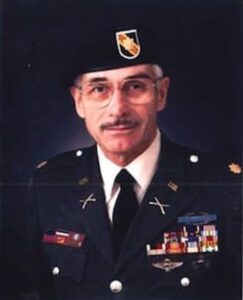
When it comes to Medal of Honor recipients and any war hero, their experiences vary. Many are on their first deployment, some have fought only few battles, and then there are servicemen and women like Lieutenant Colonel Stanley T. Adams. Adams served in World War II, fighting in North Africa and Italy and later in both the Korean War and Vietnam War. He was one of the most experienced war veterans in his division when he received the Medal of Honor for his actions during February 1951.
On the early morning of February 4, 1951, after being in South Korea for seven months, Colonel Adams and his platoon were attacked by about 250 soldiers. After almost an hour of intense gun and mortar fire, the platoon retreated to join the position of their main company. Adams saw an opportunity to defeat the opposing soldiers by fighting in in hand-to-hand combat. Adams swiftly led 13 men from his platoon into a bayonet charge against over 125 enemy soldiers. Adams was subsequently shot in the leg and had close calls with four grenades. After an hour of hand-to-hand combat, the enemy force retreated, and orders were received for the battalion to withdraw. Even then, Adams stayed behind his men to provide additional coverage.
Adams’s charge of just fourteen men saved the entire battalion from possible disaster, killing 50 enemy soldiers and forcing the enemy to retreat.
”The only way to remove the enemy from their hilltop positions was to dig them out. Men like Sergeant Adams knew this, and effectively used the almost obsolete bayonet to accomplish their missions.”
Lieutenant Colonel Stanley T. Adams received the Medal of Honor during a White House ceremony on July 5, 1951 from President Harry S. Truman. Part of his citation reads:
M/Sgt. Adams’ superb leadership, incredible courage, and consummate devotion to duty so inspired his comrades that the enemy attack was completely thwarted, saving his battalion from possible disaster. His sustained personal bravery and indomitable fighting spirit against overwhelming odds reflect the utmost glory upon himself and uphold the finest traditions of the infantry and the military service.
Adams would remain in the Army until 1970 and is one of the few men to have fought in three large wars over the course of 28 years of service. He retired as a lieutenant colonel and would later hold an administrative position with the IRS in Alaska and eventually retired in Bend, Oregon. He lost his battle with Alzheimer’s disease in 1999 at the age of 76. In his honor and through a substantial donation left by his wife, the Oregon Veterans Home built the Stan & Jean Adams Veterans’ Community Center where his Medal of Honor is on display.
Stanley T. Adams is one of the 3,500 Medal of Honor recipients whose combat valor and civic heroics will be enshrined in the National Medal of Honor Museum at Patriots Point in Mount Pleasant, SC. These heroes deserve a home for their legacy to be shared with the next generations.
As the only military museum to recognize all branches of the armed services, it will highlight the fact that the recipients of our nation’s highest military award not only defended our country, they were instrumental in developing, designing, and enriching it.
The museum will be a vault for the values embodied in the medal: courage, sacrifice and patriotism. It will showcase the Congressional Medal of Honor Foundation Character Development Program, including living histories of over 100 recipients. It will also house the Citizens Heroes Program honoring ordinary citizens who have epitomized the concept of “service above self”.
Americans will walk out of that museum with the conviction that they too can be a hero, inspired by the values of courage and sacrifice that the Medal of Honor recipients used to excel in combat and in civilian life. Learn more at mohmuseum.org.



